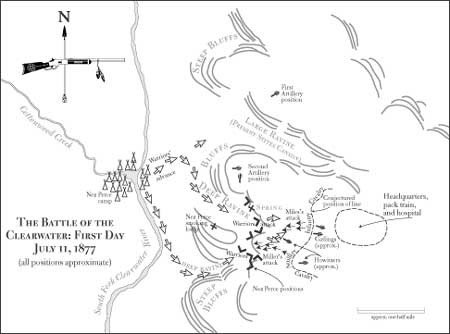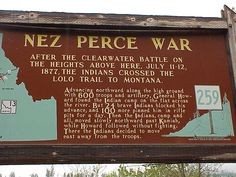The Nez Perce at Battle of the Clearwater
Introduction
Text-to-speech Audio
Images
A diagram of the Battle of the Clearwater

A plaque located south of Stites on Highway 13 commemorating the Battle of the Clearwater

Backstory and Context
Text-to-speech Audio
Eight years later in 1863, another treaty took ninety percent, six million acres, of Nez Perce land away after more gold was discovered there. Feeling betrayed, Old Chief Joseph denounced the United States, burned his American flag and Bible, and refused to sign the second treaty unlike many other Nez Perce bands who signed and relocated to the Lapwai Reservation in Idaho Territory. The United States government held all Nez Perce to the treaty, although only 1/3 of the Nez Perce chiefs signed it. In 1873, President Ulysses S. Grant issued an Executive Order that divided the land of the Wallowa Country into homestead sites and an Indian reservation. Caving to pressure from white settlers, President Grant revoked the order protecting part of the valley for the Nez Perce, essentially opening it all to settlers and closing it partially to the Nez Perce. As many as thirty Nez Perce died at the hands of settlers during the 1860’s and 70’s; yet few of those accused were ever brought to trial and even so, none were found guilty for their crimes.
The tension reached a boiling point when two settlers accused the Nez Perce of stealing horses and shot one of Young Chief Joseph’s close friends, Wind Blowing; the horses were later found on the settler’s own property. Fearing the Nez Perce’s retaliation, the settlers of the Wallowa Country demanded government intervention. Major Henry Clay Wood held a council at Fort Lapwai to resolve the situation and promised the Nez Perce representatives that the settlers who killed Wind Blowing would be held accountable to the law. However, the men walked free despite Major Wood and General Howard’s best efforts.
In May 1877, the United States government ordered the Wallowa band of Nez Perce to leave under an 1863 treaty, which Old Chief Joseph never signed. They were allowed thirty days to gather their cattle and two thousand horses and move from Wallowa County to resettle in Lapwai, Idaho. After Federal officials ignored Young Chief Joseph’s pleas for the Nez Perce people, the tribe met the deadline. With approximately 750 Nez Perce—500 of which were women, children, and elderly—Chief Joseph embarked on a prolonged battle that spanned three states and 1,200 miles with over 2,000 soldiers involved.
Originally, the Nez Perce chiefs made the difficult decision to relocate to the Lapwai Reservation to preserve the Nez Perce to posterity. However, on the eve of their departure, twenty of the bands’ youth avenged the wrongful deaths of their brethren by killing about twenty settlers. Left with few choices, the Nez Perce began to flee and fight. At the Battle of White Bird Creek a civilian accompanying the U.S. Army under General Howard shot and killed a Nez Perce representative waving a truce flag. Betrayed and threatened, the Nez Perce strategically attacked the numerically superior U.S. Army at White Bird Creek on June 17, 1877, inflicting heavy causalities and suffering only a handful. The Nez Perce battled their way to Yellowstone National Park to find refuge with their allies the Crows. Afraid of the U.S. Army’s potential retaliation for sheltering the Nez Perce, the Crows turned them away. The Nez Perce then fled wholeheartedly to Canada, as Sitting Bull had before them. At the Battle of Bear Paw, forty miles from projected freedom in Canada, the Nez Perce’s epic journey ended after a five-day battle and siege. Chief Joseph delivered his famous words “I Will Fight No More Forever” and made a treaty with General Miles permitting the Nez Perce people to relocate to the Lapwai Reservation in Idaho, as was originally intended.
However, the United States government failed to recognize the treaty forged between Chief Joseph and General Miles, instead sending the Nez Perce to reservations in Kansas and later Oklahoma before eventually allowing them to return to the Pacific Northwest. The Nez Perce’s journey was not made in vain. Their epic struggle was well documented in the newspapers and garnered public sympathy for the Native Americans’ cause. Chief Joseph, called “the Red Napoleon” although he was not the Nez Perce’s military strategist or war chief, became a political advocate and spoke in Washington, D.C., on behalf of the Native American’s plight. Four thousand Nez Perce live on reservations in the Pacific Northwest today, continuing the legacy of the historic Nez Perce.
